Introduction
Interest in mushrooms has increased worldwide in recent years because of their nutritional and promoting health properties.1 Generally, mushrooms are rich in dietary fiber, low in fat, and some essential amino acids, including bioactive polysaccharides (lentinan), ergosterol, vitamin B1 (thiamin), B2 (riboflavin), vitamin C, and minerals. Mushrooms have a high protein content2 and highly efficient bio-conversion.3 Beyond the nutritional characteristics, this is widely reported and extensively explored in the literature that mushrooms have also been attractive to be studied for their richness in bioactive compounds, such as antioxidant, anticancer, and antimicrobial properties, increased liver function, and cholesterol-lowering activity among other bio-activities. 4
Agaricus bisporus mushroom is one of the more popular mushrooms, with almost 34.8 billion kg of total world production in 2013.5 However, fresh A. bisporus is highly perishable by nature and has a short shelf-life in the ambient environment, owing to their high moisture contents, lack of physical protection to prevent water loss or microorganism attack 6, 7, and extreme sensitivity to heating.8 Therefore, mushrooms are usually used as processed products.9 Among the various methods used in mushrooms preservation, canning is the most frequently used method on the commercial scale. However, it is well known that heat processing may cause quality changes and reduce the content or bioavailability of some bioactive compounds that are relatively unstable to heat.10 Excessive heating during the sterilization process resulting in low quality.11 These quality impacts of thermal processes have always been under constant primary attention and development for researchers and the food industry since product quality is always an essential parameter for consumer acceptance.
During the sterilization process, the effect of temperature and heating time on pathogenic microorganisms is commonly represented by the F0-value. F0-value is the time in minutes for the specified temperature that gives the same thermal lethality as at 121°C in one minute. Previous studies have explored the effects of thermal processing on antioxidant activities and soluble protein contents for various food products. Murcia, Martinez-Tome, Jimenez, Vera, Honrubia and Parras12 also reported that canning reduced the antioxidant capacity of truffles. Phenolic compounds were decreased in grains13 and curruquilla14 after canning. The canning process produced a significant loss of total phenolic content in A. bisporus 15. Choi, Lee, Chun, Lee and Lee 16 reported that antioxidant activities or DPPH radical scavenging activities (free and bound polyphenolic and flavonoid contents) of Shiitake mushroom decreased during 15 to 30 minutes at the heating temperature of 121 °C. Previous research also showed that canning decreased the values of phenolics (38–56% and antioxidant activity (16–35%) of peach palm heart (Bactris gasipaes) 17 and also in grains. 18
Furthermore, the effect of retorting on the soluble protein has been reported by previous researchers, such as Chiang, Yen and Mau 19, who found that the total free amino acids contents are lost in canned mushrooms. Jaworska, Bernaś and Mickowska 20 also reported a significant decline of arginines, glycines, serines, histidines, methionine, and threonine in mushroom canned foods (1-31%). The process also resulted in a corresponding reduction of 80.1% in total free amino acids and 85% in essential amino acid contents in canned A. bisporus.21 Researchers recently reported that high temperatures (130°C) reduce casein solubility that was associated to molecular interactions, and vary depending on the heating temperature.22
Interestingly, it is still arguable whether the change of food quality due to sterilization could also be solely described as a function of the F0-value. 15,16,31 Limited data is available to systematically explore the impact of heating time-temperature on mushrooms. Therefore, this paper aims to study the effects of sterility values (F0-value) and retort temperatures of various time-temperature combinations on antioxidant activities, total soluble protein, and pH-value of canned Agaricus bisporus mushrooms.
Materials and Methods
Materials
Fresh A. bisporus mushroom cultivated in Probolinggo, East Java, Indonesia, was kept fresh by storing at 4 °C.23 The equipment used was a horizontal static retort with a diameter of 1.25 m and a length of 2.35 m (Chi Yinfa, Taiwan). Temperature measurement and recording were done using the OM-CP-Hitemp140 data logger (Omega Engineering, Norwalk, Connecticut, USA). OM-CP-Hitemp140 data logger can measure temperatures up to 140 °C (284 °F), with an accuracy of ±0.1 °C (0.18 °F). Eppendorf 5810R centrifuge (Hamburg, Germany), a UV-Visible Spectrophotometer (U-2900, Hitachi, Tokyo, Japan), a digital analytical balance (Fujitsu AR-210, Japan), a digital pH-meter (Milwaukee MW801, USA), and the eight-mesh stainless steel filter (Fisher Scientific Company, USA) were also used in this study. Methanol (Merck, Darmstadt, Germany), (DPPH) 2,2′-diphenyl-1-picrylhydrazyl (Sigma Aldrich, St. Louis, USA) were used in this study. All the chemicals were of high analytical grade. Bidistilled deionized water was obtained from IPB University.
Canning Procedure and Analysis
Preparation of Agaricus bisporus samples before canning followed the procedure used in one of the mushroom canning industries (PT. Suryajaya Abadiperkasa).23 Mushrooms were stored one day at the temperature of 3-5 °C before the canning process. The canning steps were material preparation, blanching, filling into cans, filling medium (citric acid, ascorbic acid, and NaCl), exhausting, seaming, sterilizing, cooling, and storing (Figure 1). The retort consisted of three baskets loaded jumbly with the cans, and each basket was filled with 700 cans (full capacity conditions). Control mushroom samples were taken shortly after the seaming process or just before the retorting process. In contrast, the treated product samples were taken after the sterilization process according to the design of the experiment at different retort temperatures (115, 121, and 130 °C).
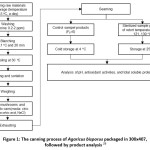 |
Figure 1: The canning process of Agaricus bisporus packaged in 300×407, followed by product analysis 23 |
F0-value Calculation
F0-value was calculated based on heat penetration data referred to the Institute for Thermal Processing Specialists (IFTPS) protocol.26 Heat penetration tests were conducted by placing eleven data loggers (OM-CP-Hitemp 140, Omega Engineering, Norwalk, Connecticut, USA) in the slowest heating area. Data loggers were located at the center of the cans, and their sensors were inserted into the mushroom. The sterility value was expressed as an F0 calculated using General Method 25, as shown in Equation 1.
where F0 was the equivalent heating time (in minutes) at a constant temperature of 121.1 °C (250 °F) to inactivate C. botulinum spores, T was the product’s temperature at any given time; Tref was a reference processing temperature (121.1 °C or 250 °F), and z-value was 10 °C. Datalogger placement schemes and samples on a static horizontal retort is shown in Figure 2.23
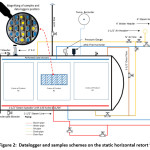 |
Figure 2: Datalogger and samples schemes on the static horizontal retort 23 |
Determination of Antioxidant Activity
Antioxidant activity was measured as free radical scavenging activity (RSA) and determined using a 1,1-diphenyl-2-picrylhydrazyl (DPPH) assay method. DPPH solution was prepared by mixing 5 mg of DPPH with 96% methanol (Merck, Darmstadt, Germany) 250 mL, stirred, and stored at 4 °C in dark conditions for less than 8 hours. Ascorbic acid was used as a solution standard prepared in different concentrations (6.25, 12.5, 25, 50, 75, and 100 ppm). RSA was determined in two types of samples, drained solid mushroom and drained liquid. Both drained samples were obtained from drained weight measurement done by draining the whole content of canned mushroom on an eight-mesh stainless steel screen (Fisher Scientific Company, USA) positioned at an angle of 20° for two minutes at ambient temperature.
RSA in drained solid mushroom was determined first by blending 206.9 ± 1.19 g sample with 80% ethanol for 2 minutes. One g of composite sample was vortexed with 10 ml of ethanol for one minute and kept at room temperature for 30 minutes. The vortexed sample was centrifuged at 3,000 RPM to separate the supernatant from the solid. One ml of the supernatant and 0.1 ml of the drained liquid was both mixed with 5 ml of DPPH solution, vortexed for 1 minute before it was stored for 30 minutes in a dark room prior to analysis. In the case of RSA in the drained liquid of canned mushrooms, the same preparation as in drained solid mushrooms was applied. Furthermore, the absorbance of the sample was measured by a UV-Vis spectrophotometer at 517 nm (triplicates) and converted into a percentage of radical scavenging activity. The activity of arrest against radical DPPH is expressed as a percent inhibitory to radical DPPH. The DPPH radical scavenging activity was calculated by the following equation:26
A0 is the absorbance of the control, and the As is the absorbance of samples.
The total RSA of canned mushrooms was the sum of both RSA in both drained solid mushrooms and drained liquid.
Determination of Soluble Protein
Soluble protein was determined according to Bradford Method (1976) in two types of samples, drained solid mushroom and drained liquid. Both drained samples were obtained from drained weight measurements done as described above. The sample was processed by using food blender for 2 minutes and filtered using a Whatman No.1 filter paper. One ml of the filtrate was taken and analyzed according to the Bradford Method (1976). Bovine Serum Albumin (BSA) was used as a solution standard ranging from a concentration of 0.1 to 1 mg/mL. The absorbance was measured with a spectrophotometer at 595 nm. The total soluble protein of canned mushrooms was the sum of both soluble proteins in both drained solid mushrooms and drained liquid.
Measurement of pH
As done in antioxidant activity and soluble protein determinations, the pH of canned mushrooms was measured in both drained solid and drained liquid. In both samples, the pH was measured after the drained solid mushrooms processed by using food blender for 30 seconds.
Statistical Analysis
The result data were statistically analyzed for analysis of variance (ANOVA). P<0.05 was considered statistically significant. All statistical analyses were conducted using MS Office Excel (2016) and SPSS 20 (IBM Corp., Armonk, NY, USA).
Results and Discussion
Radical Scavenging Activity
Mushrooms contain various secondary metabolites, such as various phenolic compounds and ergothioneine, that have been shown to act as high antioxidants.27 Phenolic acids are the major low molecular weight bioactive components usually found in mushroom species, responsible for their antioxidant properties.28
The total antioxidant activities of canned A. bisporus (drained mushroom and liquid), as determined by scavenging DPPH radical expressed in this article as RSA (Radical Scavenging Activity), are presented in Figure 3. Samples with F0=0 minutes are control samples taken before the retorting process. The RSA of mushroom samples decreases with increasing F0-values at all sterilization temperatures. The result also shows that retort temperature significantly influences the change in the RSA of the product. The antioxidant activity after the commercial sterilization process compared with the antioxidant from the control decreased from 74.25% to 71.09%.
The decreasing rate at a retort temperature of 130 °C is lower than that of 121 and 115 °C due to shorter processing times. A previous study showed that the times needed to achieve an F0-value of 10 minutes were 39.32, 11.22, and 1.30 minutes, respectively.23 It can be seen, for example, at the same F0-value of 10 minutes, the RSA at 115, 121, and 130 °C were 72.67%, 72.83%, and 73.73%, respectively. It shows that the sterilization process at a higher temperature at the same F0-value results in slightly higher antioxidant activity (Figure 3). A similar result is shown at the same F0-values. The RSA decreasing rate at a retort temperature of 130 °C is lower than other retort temperatures. At lower temperatures and a longer sterilization process, interactions between components in the food matrix occur, inhibiting the breakdown of antioxidant compounds (free polyphenol compounds) in drained liquid mushrooms. Due to the differences between the z-value of Clostridium botulinum (z = 10 °C) and the z-value of ascorbic acid (27 °C) 29, the activation energy of ascorbic acid is lower than the deactivation of microbial activity (C. botulinum). This value implies that the rate of destruction of microorganisms will be much higher than the rate of antioxidant degradation at a higher temperature. Thus, the thermal processing of food products at higher temperatures can achieve commercial sterility with better retention of antioxidant quality.
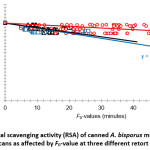 |
Figure 3: The radical scavenging activity (RSA) of canned A. bisporus mushrooms, packed in 300×407 of cans as affected by F0-value at three different retort temperatures. |
Although the total antioxidant activity of the canned A. bisporus mushrooms (drained solid mushroom and drained liquid) was decreasing, however, there was an increase in the antioxidant activity on drained solid mushrooms (Figure 4) and decreased antioxidant activity in drained liquid (Figure 5). Figure 4 shows that the (RSA) characteristic of antioxidant solubility from mushroom samples increases exponentially with increasing F0-values at all sterilization temperatures. The result also shows that retort temperature significantly influences the change in the RSA of the product. The increasing rate at a retort temperature of 130 °C is lower than that of 121 and 115 °C. At the same F0-value (10 minutes), the percentage of DPPH-radical scavenging activity at 115, 121, and 130 °C were 17.87, 17.62, and 15.94, respectively. Retorting the product at 115 °C and 121 °C caused the RSA to increase by 28.1– 30% from that of the control sample. Besides, retorting the product at 130 °C would increase RSA to 16.0%. The increase of antioxidant activity in drained solid mushrooms is probably due to the development of new compounds having antioxidant activity during heat or thermal treatment. Maillard’s reaction products might be developed during prolonged heat treatment to increase antioxidant activity in this study. Peleg, Naim, Rouseff and Zehavi 30 stated that polyphenolic compounds in plant materials are mainly present as a covalently bound form with insoluble polymers. Choi, Lee, Chun, Lee and Lee 16 stated that thermal treatment disrupts the cell wall and releases antioxidants from the insoluble part of the mushroom, which increases the pool of antioxidant compounds. In previous studies31, canning resulted in the loss of water from mushroom products or decreased drained weight. This decreasing of drained weight was one of the reasons why the antioxidant characteristics of drained solid mushrooms increased during the retorting process. Moreover, Pogoń, Gabor, Jaworska and Bernaś 32 reported that adding vegetables and spices might have caused antioxidants to migrate from the added ingredients to the canned mushrooms in more significant quantities than may have been leached from the mushrooms to the brine. This phenomenon would impact overall antioxidant activity in mushrooms, whereas the (RSA) characteristic of antioxidant solubility from mushrooms increases along with increasing F0-values.
Conversely, RSA decreases in the drained liquid of canned A. bisporus (Figure 5). The decrease rate of RSA is faster at a lower retort temperature of 115 °C due to longer processing times to achieve the same sterility value. It can be seen, for example, at the same F0-value (10 minutes), the RSA detected at 115, 121, and 130 °C were 52.83, 54.40, and 55.16, respectively. Retorting the product at 115 °C and 121 °C decreased the RSA of 10.1-12.7% from that of the control sample, whereas at 130 °C would result in the RSA decrease of 8.8% due to shorter sterilization times.
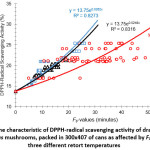 |
Figure 4: The characteristic of DPPH-radical scavenging activity of drained solid A. bisporus mushrooms, packed in 300×407 of cans as affected by F0-value at three different retort temperatures. |
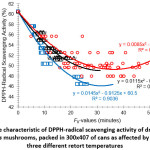 |
Figure 5: The characteristic of DPPH-radical scavenging activity of drained liquid A. bisporus mushrooms, packed in 300×407 of cans as affected by F0-value at three different retort temperatures |
Soluble Protein Content
Nutritional contents and bioactive components of edible mushrooms depend on the processing technique used, which influences the chemical composition and commercial value of edible mushrooms 8. The total soluble protein of samples (Figure 6) decreases with increasing F0-values at all sterilization temperatures. The decreasing rate at a retort temperature of 130 °C is lower than that of the retort temperatures of 121 and 115 °C due to shorter processing times to achieve the same F0-value. For example, at the same F0-value of 10 minutes, it can be seen that the total of soluble protein at 115, 121, and 130 (C were 23.92, 23.97, 24.1 mg/g, respectively). Retorting the product at 115 °C and 121 °C decreased the soluble protein content by 0.6-0.8% from that of the control sample.
Moreover, retorting the product at 130 °C would decrease the soluble protein by 0.1%. It shows that the sterilization process at a higher temperature at the same F0-value will keep the soluble protein in drained solid mushrooms from denaturation or more stable. Decreasing soluble protein in drained liquid mushrooms probably due to the sterilization process resulted in changes in the chemical and physical structure of the mushroom tissues. Solubility often depends on increasing retort temperature, and increasing kinetic energy at higher temperatures allows solvent molecules to cause a change in the primary, secondary, and tertiary structure of proteins. In addition, decreasing protein in drained solid mushrooms occurred at lower temperatures, probably due to a prolonged retorting process as compared to higher retort temperature (130 °C) to achieve the same F0-value. Therefore, it causes protein denaturation and leaches in the drained liquid of canned A. bisporus. Jasinki, Stemberger, Walsh and Kilara 33 were observed using Transmission Electron Microscopy (TEM). They mentioned that high temperatures during canning caused coagulation of cytoplasmic material, and disruption of the intracellular membranes correlated mainly with the loss of cell membrane integrity. These findings of the current study are consistent with those of Zivanovic, Buescher and Kim 34, who showed increasing soluble protein in the drained liquid of mushroom products as a function of temperature (85-121 °C).
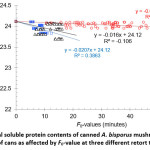 |
Figure 6: Total soluble protein contents of canned A. bisporus mushrooms, packed in 300×407 of cans as affected by F0-value at three different retort temperatures. |
Furthermore, Figures 7 and 8 show the characteristic of soluble proteins as an effect of retort temperatures (115, 121, and 130 °C) and F0-values. Samples with a value of F0=0 minutes are control samples taken before the retorting process. Figure 7 shows that the protein content decreased exponentially with increasing F0-values at all sterilization temperatures. The result also indicates that retort temperature significantly influences the change in the soluble protein of the product (P <0.05). The decline rate at the retort temperature of 130 °C is slightly lower than that of 121 and 115 °C. At the same F0-value, for example of 10 minutes, the percentage of soluble protein contents at 115, 121, and 130 °C were 10.50, 14.60, and 18.56, respectively. Retorting the product at 115 °C and 121 °C reduced the soluble protein contents by 33.6 – 52.3% from that of the control sample. On the other hand, retorting the product at 130 °C would reduce soluble protein contents by 15.6%. The soluble protein decreasing at 130 °C of retort temperature is lower than other retort temperatures due to shorter processing times. In contrast, there is increasing soluble protein in the drained liquid of canned A. bisporus (Figure 8). The increased rate of soluble protein is faster at a lower retort temperature of 115 °C. At the same F0-value achieved (10 minutes), the soluble protein content detected at 115, 121, and 130 °C were 7.99, 4.09, and 3.20 (mg/g), respectively. Retorting the product at 115 °C and 121 °C significantly increased the soluble protein rate by 93.9-278.5% than that of control sample, whereas at 130 °C would result in a soluble protein increase by 51.6%. A similar result is shown at the same F0-value of 20 minutes.
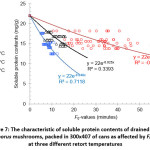 |
Figure 7: The characteristic of soluble protein contents of drained solid A. bisporus mushrooms, packed in 300×407 of cans as affected by F0-value at three different retort temperatures. |
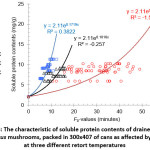 |
Figure 8: The characteristic of soluble protein contents of drained liquid A. bisporus mushrooms, packed in 300×407 of cans as affected by F0-value at three different retort temperatures |
pH value
Since pH significantly influences food safety and quality attributes, it is essential to analyze pH change as an effect of the thermal process for the safety and quality of food products. One of the critical factors that affect the thermal resistance of bacterial spores, or their ability to germinate, from a sterilization point of view, is pH25. The pH or acidity of foods is generally used to determine processing requirements and applicability. In order to provide some safety margin, the USFDA has recommended a pH value of 4.6.35
Table 1: The pH-values of drained liquid and solid of the canned A. bisporus mushrooms, packed in 300×407 of cans as affected by F0-value and retort temperature.
| Samples of Caned Mushrooms | Retort Temperatures (°C) | pH at different F0-values | ||
| 0 | 10 minutes | 20 minutes | ||
| (Control samples) | ||||
| Drained liquid | 115 | 4.22±0.08a | 5.83±0.15b | 5.45±0.16b |
| 121 | 5.78±0.11b | 5.42±0.10b | ||
| 130 | 5.50±0.04c | 5.35±0.05b | ||
| Drained Solid | 115 | 6.08±0.08a | 6.58±0.13b | 6.52±0.07b |
| 121 | 6.53±0.04b | 6.50±0.10b | ||
| 130 | 6.52±0.21b | 6.47±0.09b | ||
Values are expressed as mean ± SD (n=3); different letters within columns indicate significant differences (P <0.05).
The pH change of canned A. bisporus (drained liquid and solid) as affected by F0-value and retort temperature is presented in Table 1. Samples with a value of F0=0 minutes are control samples taken before the retorting process. The pH value of mushroom samples slightly increases with increasing F0-values at all sterilization temperatures than control samples (F0=0 minute), P<0.05. The pH value of drained liquid and solid mushroom after the commercial sterilization process compared with the pH of the control samples increased from 4.22 to 5.83 and 6.08 to 6.58, respectively. The higher retort temperature and shorter processing time, the more it can maintain the pH value or be more stable.
While at lower sterilization temperatures and longer heating times result in more hydrolyzed mushroom proteins, especially basic amino acids, such as lysine, arginine, and histidine. As shown in Table 1, at F0 = 10 minutes at retort temperatures 115, 121, and 130 °C, the pH values achieved are 5.83, 5.78, and 5.50, respectively. It shows that the process at a higher temperature at the same F0-value will slightly protect the basic of amino acids in canned mushrooms from hydrolysis. A similar result is shown at F0=20 minutes for both drained liquid and solid mushrooms. This result supports other finding 36, which showed that processing caused an increase in pH due to heating. Higher retort temperature causes more cell wall damage than lower retort temperature. At higher temperatures, the cell and tissue structure shrinks, releases water in the tissue, causes protein denaturation, and releases hydrogen ions.
Lund and Ray 37 reported that any solution’s temperature increase would increase its ions’ mobility in the solution. Increased temperature may also increase the number of ions in the solution due to molecular dissociation. Based on this fact, it can be said that the pH-value of the drained liquid of canned mushrooms is influenced by retort temperature and F0-values.
Conclusion
This study demonstrates that the canning process of A. bisporus mushroom at various F0-values and different sterilization temperatures of 115, 121, and 130 °C results in changes in chemical quality attributes. Our findings show that the canning process led to changes in antioxidant activities, soluble protein, and pH-value, which depend not only on the F0-value but also on retort temperature. At the same F0-value (e.g., 10 minutes), we found that retorting the product at a higher retort temperature of 130 °C would provide benefits such as a lower decrease in the soluble protein and antioxidant activity of canned mushrooms. Moreover, selecting the higher retort temperature (130 °C) also results in a lower pH value than other retort temperatures of 115 and 121 °C. The use of a higher temperature and shorter time is more favorable than that of a lower temperature and longer time of retorting from antioxidant activity, soluble proteins content, and pH-value properties point of view.
Acknowledgment
This study was supported by the Indonesian FDA, The Republic of Indonesia, under Grant [KP.03.01.243.08.15.05524]. We would like to thank all staff of PT Suryajaya Abadiperkasa for their kind support during this research.
Conflicts of Interest
The author(s) declare(s) that there is no conflict of interest regarding the publication of this paper.
Funding Sources
This work was funded by the Indonesian FDA, with project number KP.03.01.243.08.15.05524.
References
- Sun L-b, Zhang Z-y, Xin G, et al. Advances in umami taste and aroma of edible mushrooms. Trends in Food Science & Technology. 2020;96:176-187. doi:10.1016/j.tifs.2019.12.018
CrossRef - Reis FS, Barros L, Martins A, Ferreira IC. Chemical composition and nutritional value of the most widely appreciated cultivated mushrooms: an inter-species comparative study. Food Chem Toxicol. Feb 2012;50(2):191-7. doi:10.1016/j.fct.2011.10.056
CrossRef - RÓZsa S, Gocan T-M, LazĂR V, et al. The Effect of Processing on Chemical Constituents of Agaricus spp. Mushrooms. Notulae Botanicae Horti Agrobotanici Cluj-Napoca. 2017;45(2):507-516. doi:10.15835/nbha45210764
CrossRef - Atila F, Owaid MN, Shariati MA. The Nutritional and Medical Benefits of Agaricus bisporus : A Review. Journal of Microbiology, Biotechnology and Food Sciences. 2017;7(3):281-286. doi:10.15414/jmbfs.2017/18.7.3.281-286
CrossRef - Royse DJ, Baars J, Tan Q. Current Overview of Mushroom Production in the World. Edible and Medicinal Mushrooms. 2017:5-13.
CrossRef - Fernandes A, Antonio AL, Oliveira MB, Martins A, Ferreira IC. Effect of gamma and electron beam irradiation on the physico-chemical and nutritional properties of mushrooms: a review. Food Chem. Nov 15 2012;135(2):641-50. doi:10.1016/j.foodchem.2012.04.136
CrossRef - Joshi K, Warby J, Valverde J, Tiwari B, Cullen PJ, Frias JM. Impact of cold chain and product variability on quality attributes of modified atmosphere packed mushrooms (Agaricus bisporus) throughout distribution. Journal of Food Engineering. 2018;232:44-55. doi:10.1016/j.jfoodeng.2018.03.019
CrossRef - Xue Z, Hao J, Yu W, Kou X. Effects of Processing and Storage Preservation Technologies on Nutritional Quality and Biological Activities of Edible Fungi: A Review. Journal of Food Process Engineering. 2017;40(3)doi:10.1111/jfpe.12437
CrossRef - Jaworska G, Bernaś E. The effect of preliminary processing and period of storage on the quality of frozen Boletus edulis (Bull: Fr.) mushrooms. Food Chemistry. 2009;113(4):936-943. doi:10.1016/j.foodchem.2008.08.023
CrossRef - Rawson A, Patras A, Tiwari BK, Noci F, Koutchma T, Brunton N. Effect of thermal and non thermal processing technologies on the bioactive content of exotic fruits and their products: Review of recent advances. Food Research International. 2011;44(7):1875-1887. doi:10.1016/j.foodres.2011.02.053
CrossRef - Anderson NM, Walker PN. Quality comparison of continuous steam sterilization segmented-flow aseptic processing versus conventional canning of whole and sliced mushrooms. J Food Sci. Aug 2011;76(6):E429-37. doi:10.1111/j.1750-3841.2011.02221.x
CrossRef - Murcia MA, Martinez-Tome M, Jimenez AM, Vera AM, Honrubia M, Parras P. Antioxidant activity of edible fungi (truffles and mushrooms): losses during industrial processing. J Food Prot. Oct 2002;65(10):1614-22. doi:10.4315/0362-028x-65.10.1614
CrossRef - Parmar N, Singh N, Kaur A, Virdi AS, Thakur S. Effect of canning on color, protein and phenolic profile of grains from kidney bean, field pea and chickpea. Food Res Int. Nov 2016;89(Pt 1):526-532. doi:10.1016/j.foodres.2016.07.022
CrossRef - Pedrosa MM, Cuadrado C, Burbano C, et al. Effects of industrial canning on the proximate composition, bioactive compounds contents and nutritional profile of two Spanish common dry beans (Phaseolus vulgaris L.). Food Chem. Jan 1 2015;166:68-75. doi:10.1016/j.foodchem.2014.05.158
CrossRef - Vivar-Quintana AM, González-San José ML, Collado-Fernández M. Influence of canning process on colour, weight and grade of mushrooms. Food Chemistry. 1999;66(1):87-92. doi:10.1016/S0308-8146(98)00247-7
CrossRef - Choi Y, Lee SM, Chun J, Lee HB, Lee J. Influence of heat treatment on the antioxidant activities and polyphenolic compounds of Shiitake (Lentinus edodes) mushroom. Food Chemistry. 2006;99(2):381-387. doi:10.1016/j.foodchem.2005.08.004
CrossRef - Stevanato N, Ribeiro TH, Giombelli C, et al. Effect of canning on the antioxidant activity, fiber content, and mechanical properties of different parts of peach palm heart. https://doi.org/10.1111/jfpp.14554. Journal of Food Processing and Preservation. 2020/08/01 2020;44(8):e14554. doi:https://doi.org/10.1111/jfpp.14554
CrossRef - Parmar N, Singh N, Kaur A, Virdi AS, Thakur S. Effect of canning on color, protein and phenolic profile of grains from kidney bean, field pea and chickpea. Food Research International. 2016;89(Pt 1):526-532. doi:10.1016/j.foodres.2016.07.022
CrossRef - Chiang P, Yen C, Mau J. Non-volatile taste components of canned mushrooms. Food Chemistry. 2006;97(3):431-437. doi:10.1016/j.foodchem.2005.05.021
CrossRef - Jaworska G, Bernaś E, Mickowska B. Effect of production process on the amino acid content of frozen and canned Pleurotus ostreatus mushrooms. Food Chemistry. 2011;125(3):936-943. doi:10.1016/j.foodchem.2010.09.084
CrossRef - Martín-Belloso O, Llanos-Barriobero E. Proximate composition, minerals and vitamins in selected canned vegetables. European Food Research and Technology. 2001;212(2):182-187. doi:10.1007/s002170000210
CrossRef - Zenker HE, Raupbach J, Boeren S, Wichers HJ, Hettinga KA. The effect of low vs. high temperature dry heating on solubility and digestibility of cow’s milk protein. Food Hydrocolloids. 2020/12/01/ 2020;109:106098. doi:https://doi.org/10.1016/j.foodhyd.2020.106098
CrossRef - Pursito DJ, Purnomo EH, Fardiaz D, Hariyadi P. Optimizing Steam Consumption of Mushroom Canning Process by Selecting Higher Temperatures and Shorter Time of Retorting. Int J Food Sci. 2020;2020:6097343. doi:10.1155/2020/6097343
CrossRef - IFTPS. Guidelines for conducting thermal processing studies. http://iftps.org/wp-content/uploads/2017/12/Retort-Processing-Guidelines-02-13-14.pdf
- Holdsworth SD, Simpson R. Kinetics of Microbial Death and Factors for Quality Attributes. Thermal Processing of Packaged Foods. 2016:89-124:chap Chapter 3. Food Engineering Series.
CrossRef - Heleno SA, Barros L, Martins A, et al. Chemical composition, antioxidant activity and bioaccessibility studies in phenolic extracts of two Hericium wild edible species. LWT – Food Science and Technology. 2015;63(1):475-481. doi:10.1016/j.lwt.2015.03.040
CrossRef - Ghahremani-Majd H, Dashti F. Chemical composition and antioxidant properties of cultivated button mushrooms (Agaricus bisporus). Horticulture, Environment, and Biotechnology. 2015;56(3):376-382. doi:10.1007/s13580-015-0124-z
CrossRef - Ferreira IC, Barros L, Abreu RM. Antioxidants in wild mushrooms. Curr Med Chem. 2009;16(12):1543-60. doi:10.2174/092986709787909587
CrossRef - Toledo RT, Singh RK, Kong F. Fundamentals of Food Process Engineering (Food Science Text Series). 2018.
CrossRef - Peleg H, Naim M, Rouseff RL, Zehavi U. Distribution of bound and free phenolic acids in oranges (Citrus sinensis) and Grapefruits (Citrus paradisi). Journal of the Science of Food and Agriculture. 1991;57(3):417-426. doi:10.1002/jsfa.2740570312
CrossRef - Anantheswaran RC, Sastry SK, Beelman RB, Okereke A, Konanayakam M. Effect of Processing on Yield, Color and Texture of Canned Mushrooms. Journal of Food Science. 1986;51(5):1197-1200. doi:10.1111/j.1365-2621.1986.tb13083.x
CrossRef - Pogoń K, Gabor A, Jaworska G, Bernaś E. Effect of Traditional Canning in Acetic Brine on the Antioxidants and Vitamins in Boletus edulis and Suillus luteus Mushrooms. Journal of Food Processing and Preservation. 2017;41(2)doi:10.1111/jfpp.12826
CrossRef - Jasinki E, Stemberger B, Walsh R, Kilara A. Ultrastructural Studies of Raw and Processed Tissue of the Major Cultivated Mushroom, Agaricus bisporus. Food Structure. 1984;3(2):12.
- Zivanovic S, Buescher R, Kim SK. Mushroom texture, cell wall composition, color, and ultrastructure as affected by pH and temperature. Journal of Food Science. 2003;68(5):1860-1865. doi:10.1111/j.1365-2621.2003.tb12343.x
CrossRef - Nutrition FCfFSA. Approximate pH of Foods and Food Products. Department of Health and Human Services. 2008;(April 2007):1-13.
- Sapers GM, Panasiuk O, CarrÉ J. Effects of Thermal Processing and Salt on The pH and Acidity of Home Canned Tomatoes. Journal of Food Science. 1978;43(3):951-953. doi:10.1111/j.1365-2621.1978.tb02461.x
CrossRef - Lund MN, Ray CA. Control of Maillard Reactions in Foods: Strategies and Chemical Mechanisms. J Agric Food Chem. Jun 14 2017;65(23):4537-4552. doi:10.1021/acs.jafc.7b00882
CrossRef

This work is licensed under a Creative Commons Attribution 4.0 International License.








